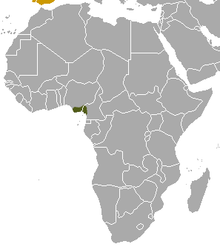Crested gorse
| Crested gorse | ||||||||||||
|---|---|---|---|---|---|---|---|---|---|---|---|---|

Crested gorse ( Genetta cristata ) |
||||||||||||
| Systematics | ||||||||||||
|
||||||||||||
| Scientific name | ||||||||||||
| Genetta cristata | ||||||||||||
| Hayman , 1940 |
The hood genet ( genetta cristata ; also Niger Genette or Niger genet) is one of the 15 types of the genus of genet . The crested gorse, native to parts of Nigeria and Cameroon, lives in forest areas and is considered endangered.
features

The basic color of the upper side of the body is yellowish-brown to ocher, the shoulders and the middle of the back have the darker tones. The spots are dark brown to black and arranged in longitudinal rows. The spots in the top rows are arranged relatively evenly; the spots become smaller and more irregular towards the bottom. Between the shoulder and tail runs a dark dorsal stripe from longer hair, the hair on the back center can be set up like a comb. The face shows a black mask between pairs of white spots. The proportion of light-colored tail rings is 50–75%, the tip of the tail is light gray. The head-torso length is 49-62 cm, the mass around 2.5 kg.
Distribution and habitats
The distribution area of the Niger Genette (= hooded gorse cat) lies between the rivers of Sanaga (in Cameroon) and Niger (in Nigeria). Reports of finds also come from the west of the Niger Delta as well as from Gabon and the Republic of the Congo . The altitude distribution extends up to 1000 m.
In particular, areas with dense undergrowth or heavy bushes in rainforests are populated. Primary forests on the plains are of great importance, secondary forests and mountain forests are also inhabited.
Way of life
The crested gorse cat is a nocturnal predator. It feeds mainly on small mammals and arthropods such as insects . The animals can climb well and often stay far from the ground. Four types of vocalizations have been described (purring and growling, meowing, beeping, and a brief cough-like grunt as a contact call). Lifestyle details are not known.
Danger
Habitat losses through the conversion of forests into agricultural areas and through oil production in the Niger Delta represent the most important source of danger. In addition, there is likely to be intensive hunting ( bushmeat , gorse cat skins ). The IUCN assumes a population decrease of more than 30 percent in the last three generations (assuming an assumed generation duration of seven years) and classified Genetta cristata as endangered (vulnerable) in 2008 .
Taxonomy
The crested gorse cat has long been considered a subspecies of the serval gorse cat ( Genetta servalina ). This species can also hybridize in the border areas. The crested gorse itself is a monotypical species.
Individual evidence
- ↑ a b c d e J. Jennings AP & G. Veron (2009): Family Viverridae. In: DE Wilson. & RA Mittermeier (Eds.) Handbook of the Mammals of the World. Volume 1: Carnivores. Lynx Edicions, Barcelona.
- ↑ a b D. R. Rosevear (1974): The carnivores of West Africa. - Trustees of the British Museum (Natural History).
- ↑ a b H. van Rompaey, P. Gaubert & M. Hoffmann (2008). Genetta cristata. In: IUCN 2010. IUCN Red List of Threatened Species. Version 2010.4. < https://apiv3.iucnredlist.org/api/v3/taxonredirect/8998 >. Retrieved April 4, 2011.
